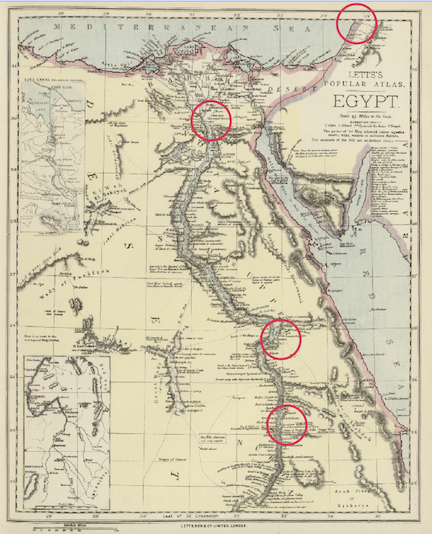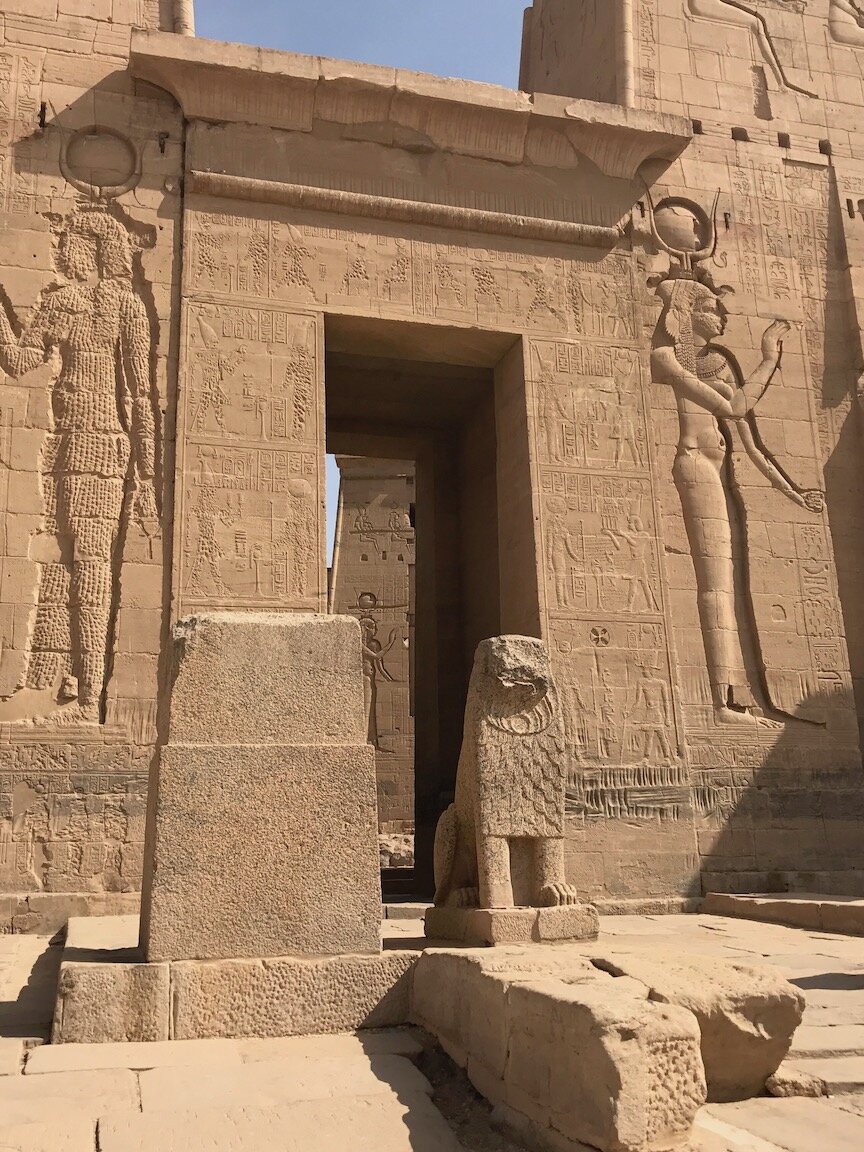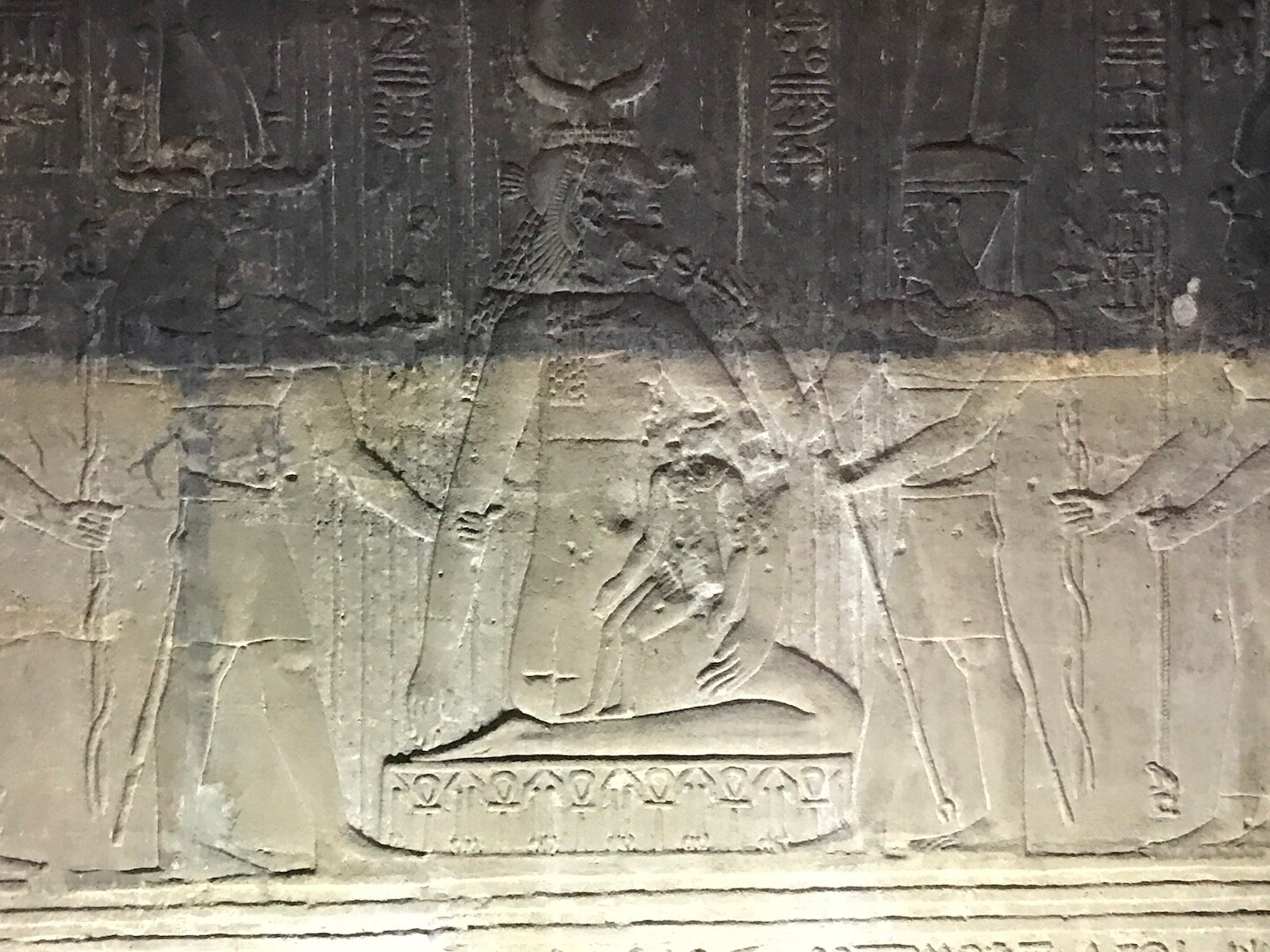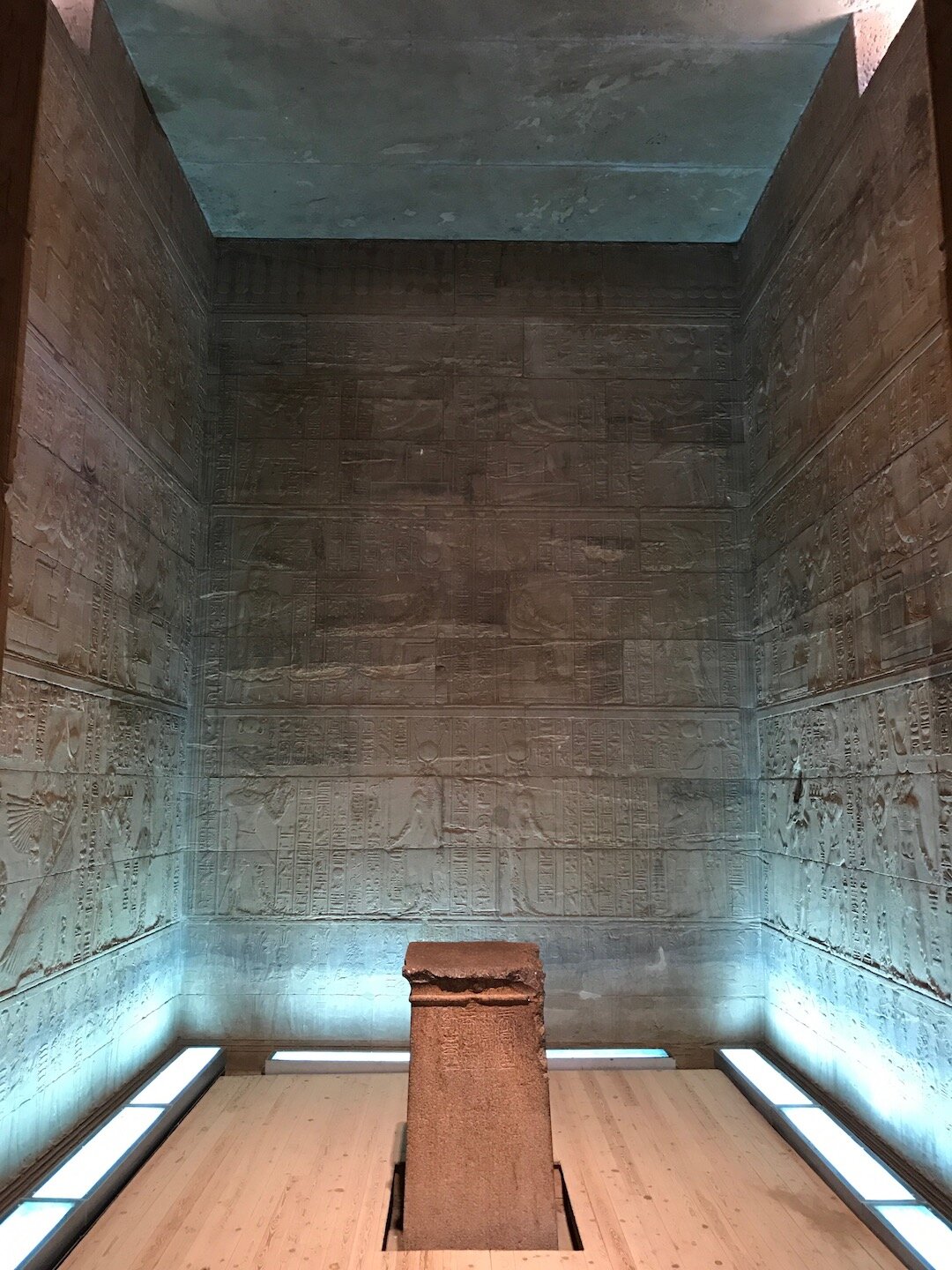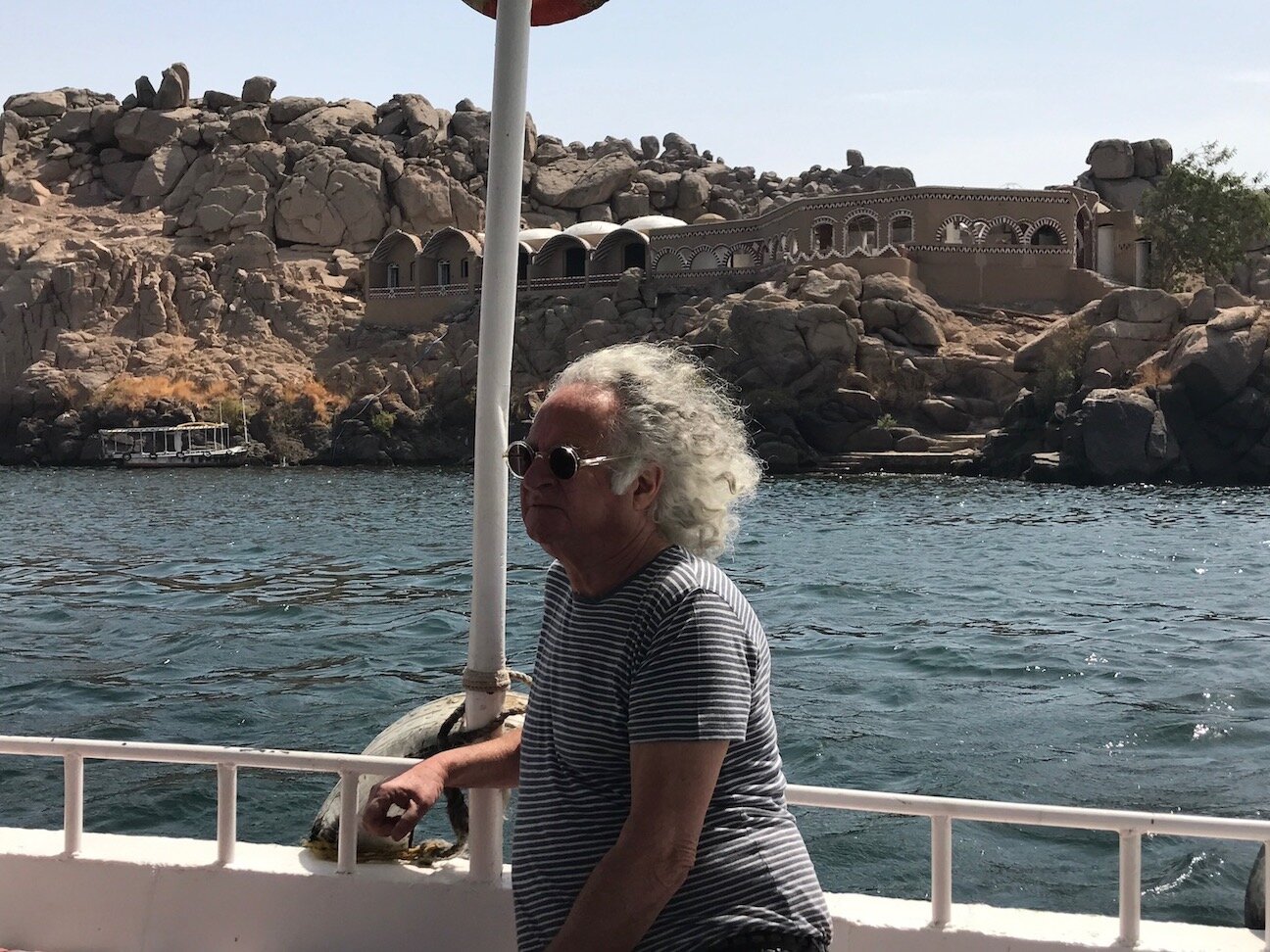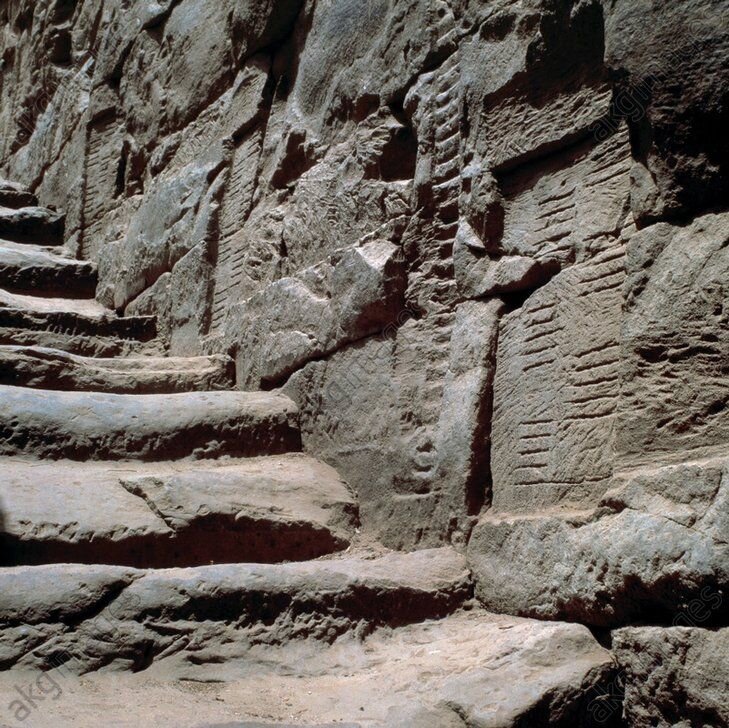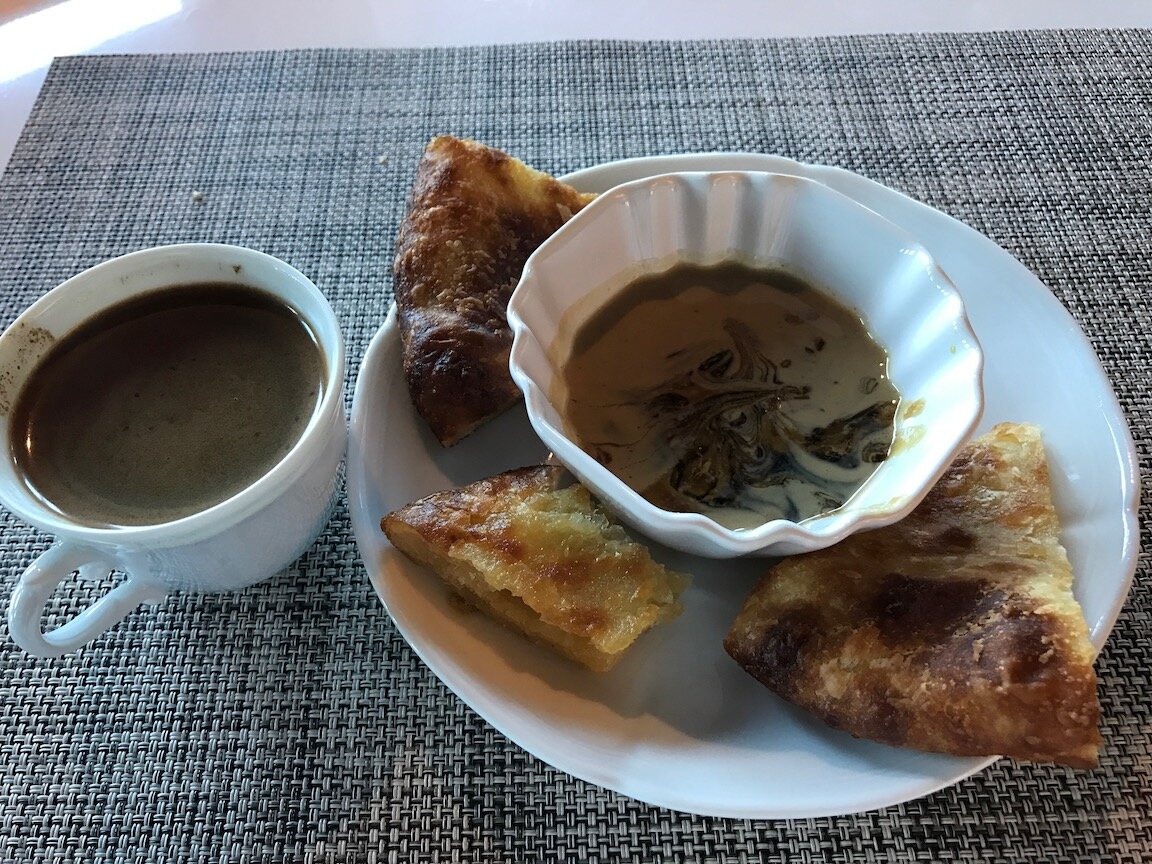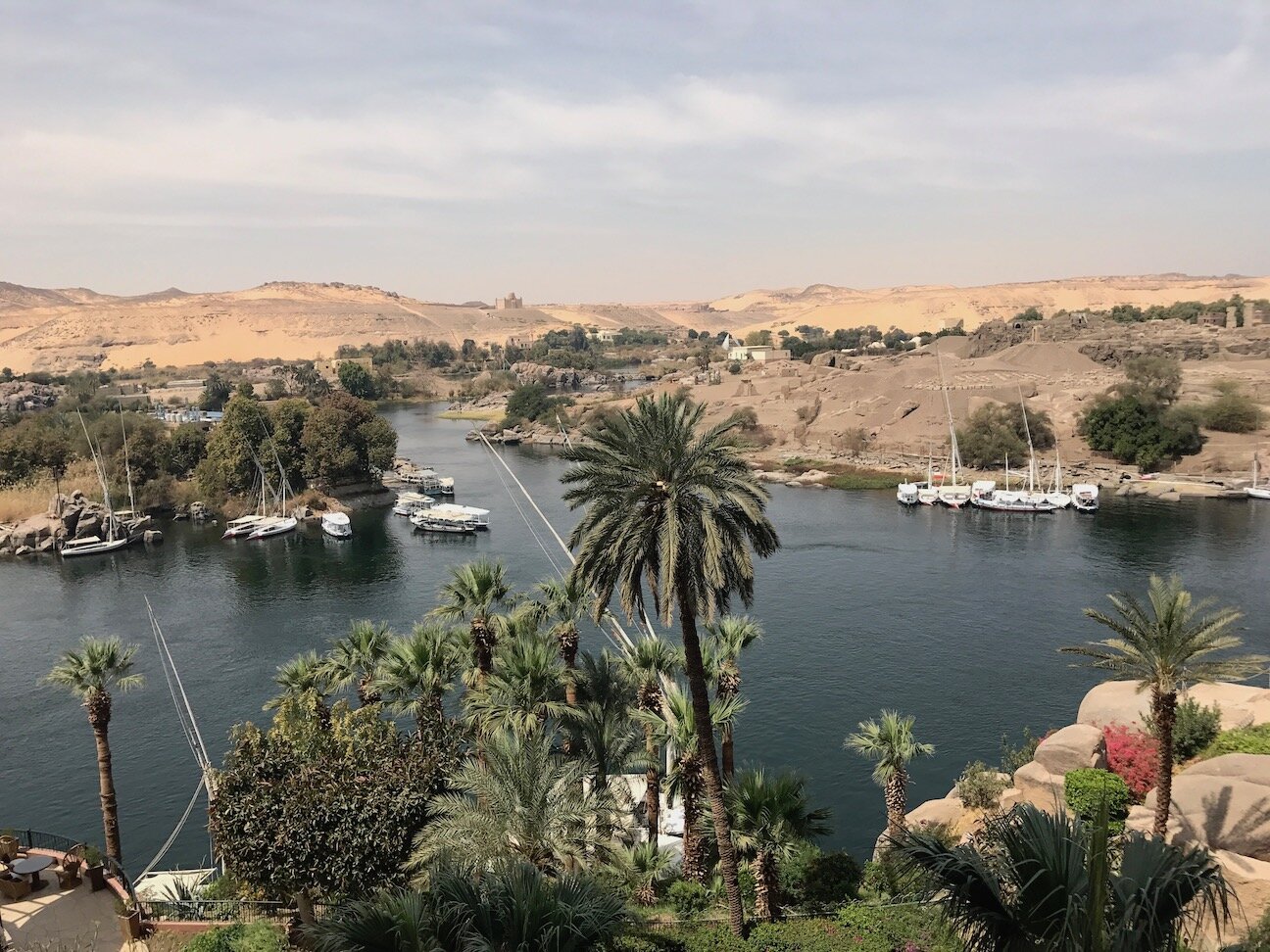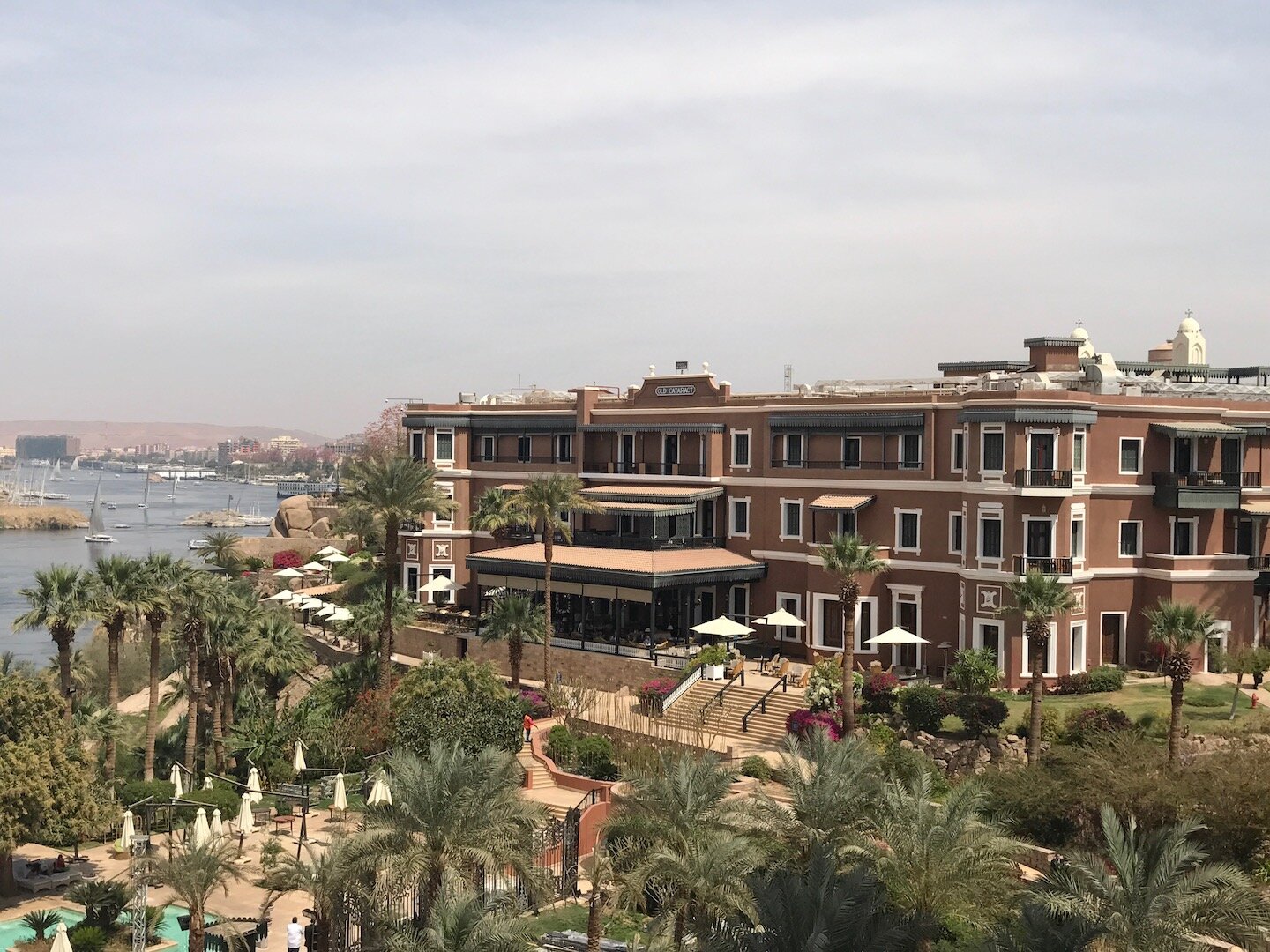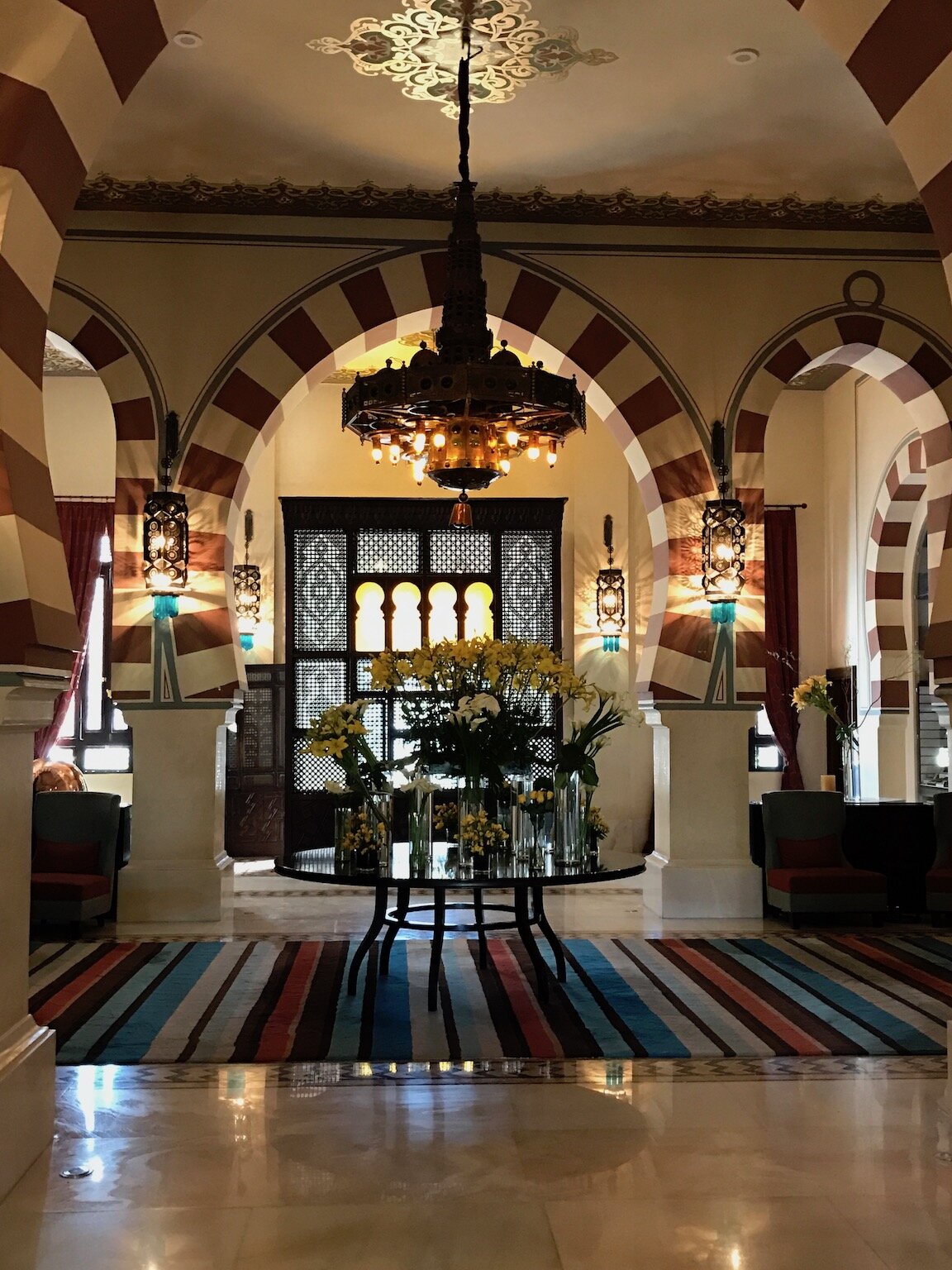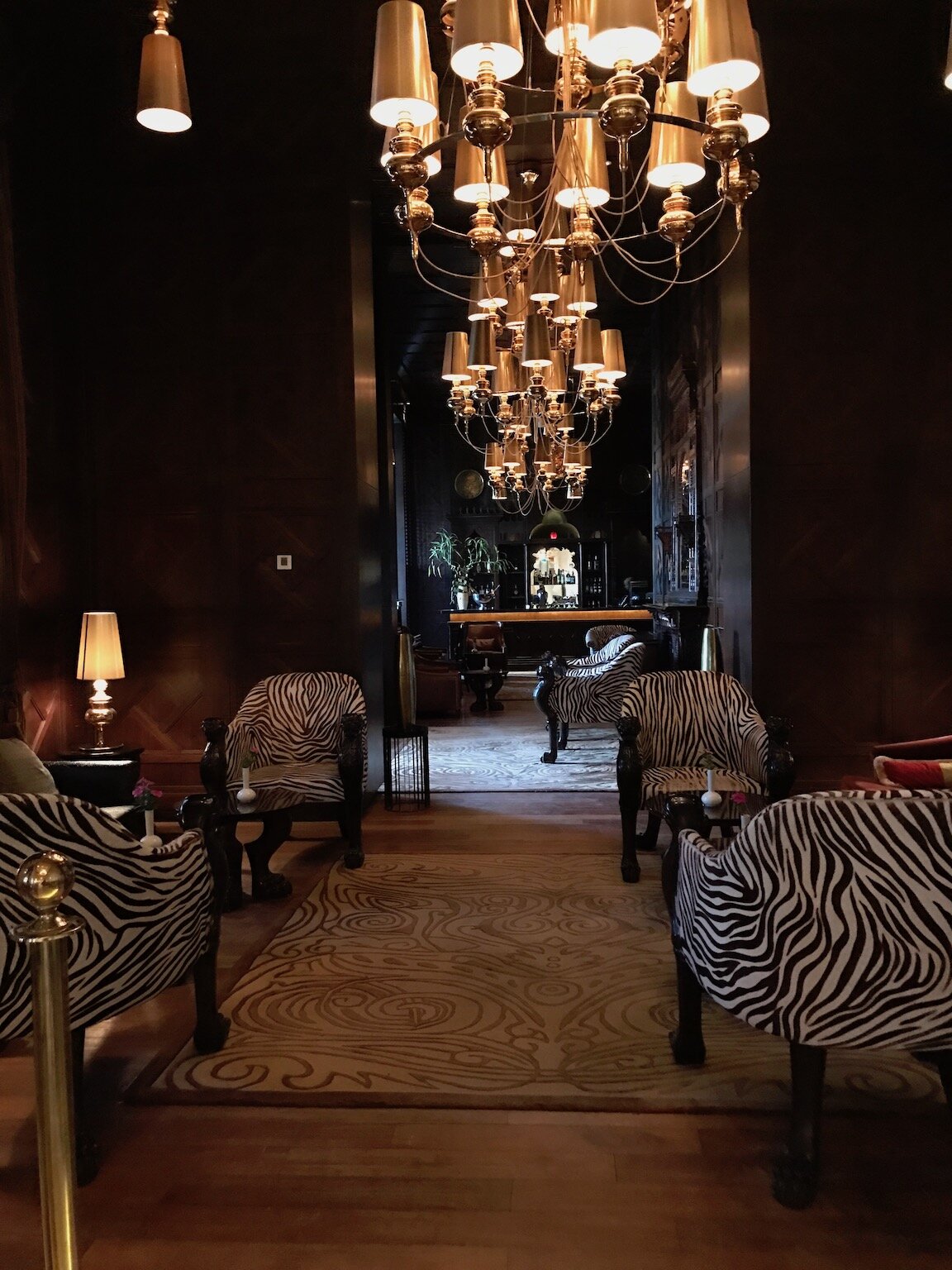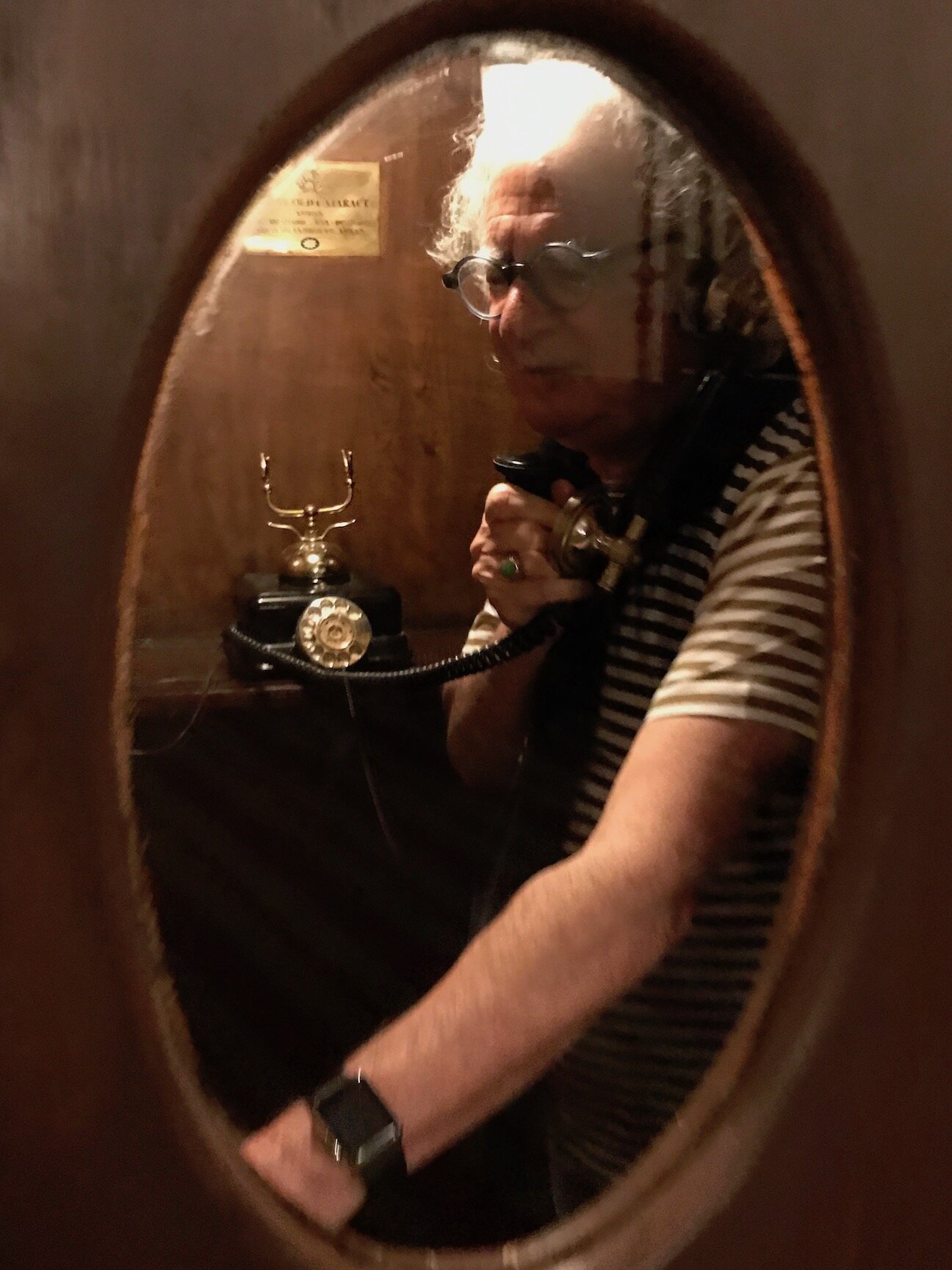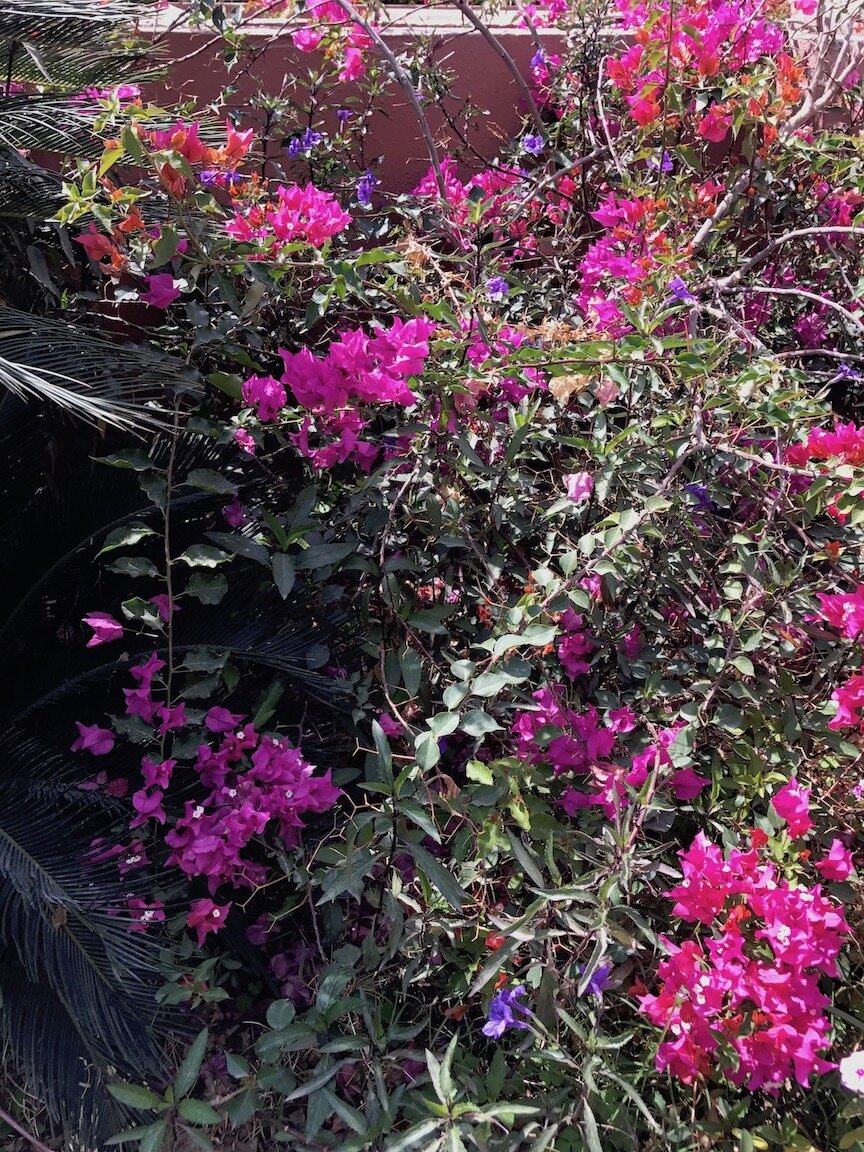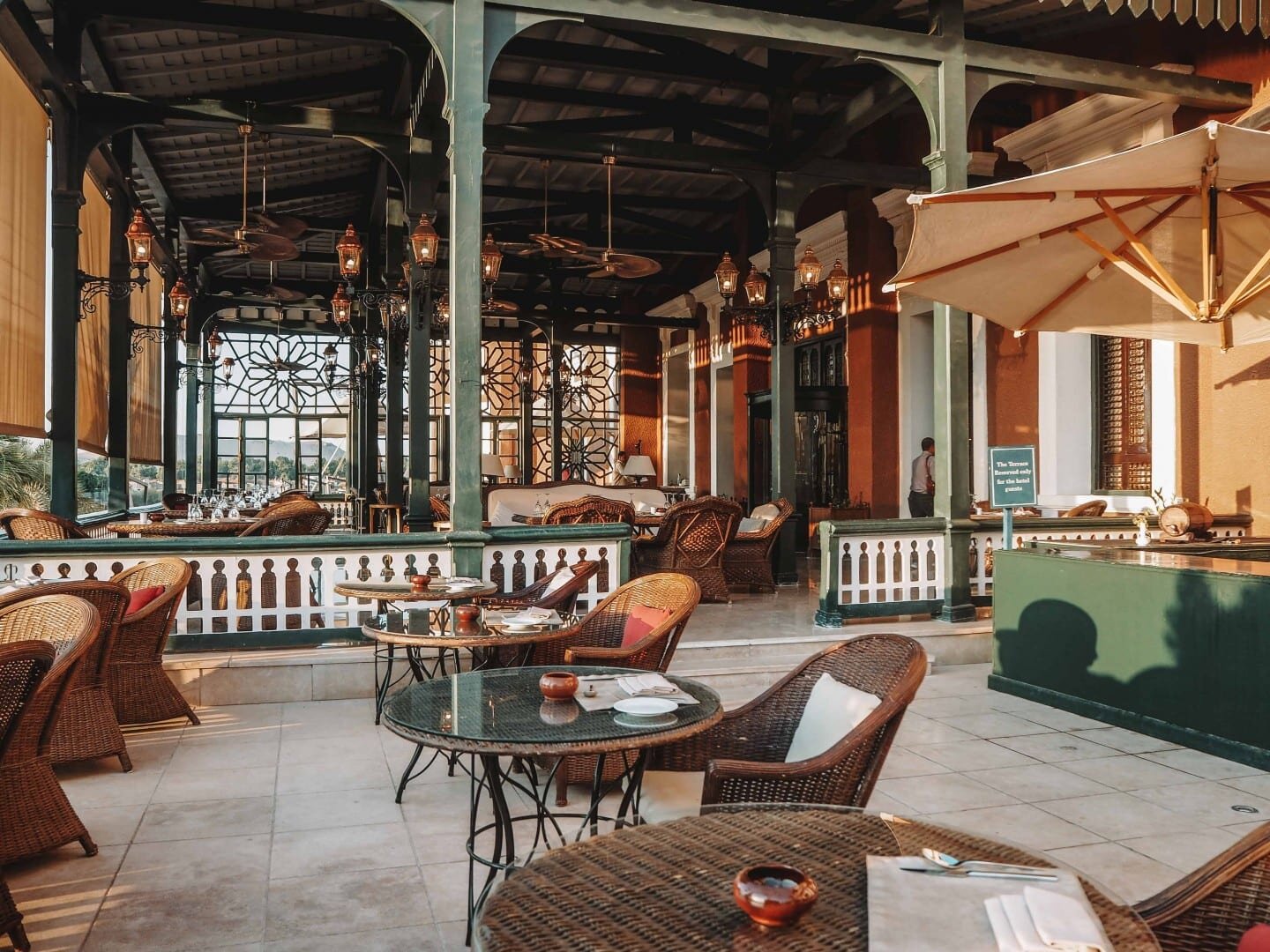[Visited in March 2017]
Day Four
In the morning the Oberoi Philae set sail for Aswan, it would be our last day and night on the ship. Aswan was originally called Swanee or Swanet, which was the name of the Egyptian symbol for ‘market’ or ‘trade,’ so it makes sense that Aswan was a trade post with markets and palaces. It’s the southern-most of the 27 provinces in Egypt. It’s considered the Gateway to Africa and so important that the son of the King was entrusted to keep it safe. The black, pink and grey granite quarries around Aswan are notable because most of the Egyptian statues, Obelisks and Pyramids are made of them.
Pink granite statue of Ramses, complete with “Champagne bucket on ice” Crown
Aswan sits on a peninsula near the first cataract of the Nile. ‘Cataracts’ are shallow waterfalls with boulders in the middle of the water, and look similar to the clouded lens of a cataract in an eye.
Approximate location of Aswan - the lowest circle on the map.
Temple of Isis
We arrived at the Island of Agilkia by Felucca (a wooden sailing boat) to see the sacred Temple of Isis.
Felucca Humor
The Temple was built by Tolemy and the Romans, and took 700 years between 300BC - 400AD to build. After the Pharoahs, more stones were added to the tops of the columns to restore the temple to its original contour by the Romans and Greeks.
In legend, Philae Island is the place where Isis found the heart of Osiris, and so it was sacred to the ancients. Isis was the Goddess of protection for Sailors. The temple of Isis was originally located on Philae Island in Upper Egypt, and was relocated to Agilkia Island so they could protect it from constant flooding during the construction of the AswanHigh Dam. From 1960-1970 all of Nubia was underwater and the Temple of Isis was also submerged.
Entrance to the Temple
The temple lasted underwater because it was made of sandstone which is fortified by water. The water did damage by fading the colors of all the paintings. Unesco came to the rescue and saved many temples. A cofferdam (an enclosure on water built around the submerged temple) was used to pump the water out. Instead of ‘filling the coffers,’ it was emptying them. Afterward, the Monuments were cleaned, measured, dismantled into 40,000 pieces, and transferred to this Agilkia.
Isis with baby Horus on her lap.
The Romans added stones to the columns, as well as a little graffiti.
The Altar where a golden statue of Isis once stood. Its now in Florence or Paris. Must have been removed prior to 1980.
A. makes an offering to the Gods.
The Obelisk that stood at the entrance to the Temple was taken by Italians in the early 19th century and sold to an antique dealer, William Bankes. Bankes bought it and put in the gardens of his estate in Dorset, England. His Obelisk, together with the Rosetta Stone found in Alexandria, Egypt, were key to deciphering the Egyptian language. We learned that until as recently as 1980, anything taken from Egypt could be kept, and after that they were only able to get artifacts back by negotiating.
The birth-house, also called the Mammisi, is a small chapel attached to the temple celebrating the divine birth of the Pharaoh. Vintage shot borrowed from the internet.
A view of the Temple from the water
The Aswan Dams
The Aswan Low Dam, or the Old Aswan Dam was built by the British from 1889-1902. It had numerous gates that would release the stored water every year into the floodplains of the Nile. Because it held no water in reserve, it would occasionally release too much water and flood the crops, or too little water and create a famine. The height of the Dam walls was increased twice in order to create more storage, but with the creation of the Aswan High Dam, the Old Aswan Dam became just a housing for the existing two power plants.
A view from the Aswan High Dam
The Aswan High Dam was built between 1960 and 1970 with the money for design, engineering, machinery and construction contributed by the Russians. The goal for the new Dam was to have more control over the release of water, and to maintain storage for irrigation to support the farmers, especially for their world famous Egyptian Cotton. Our guide mentioned that if the Dam is damaged, Egypt would flood in 32 hours from Aswan to Alexandria. The Good News is they have massive security and a no-fly zone overhead. The Dam generates energy and regulates the Nile so that there are now 3 crop cycles a year. The Bad News is that water still needs to be pumped out to protect the nearby temples. Also, the water has lost many of its’ natural nutrients which have acted as fertilizer for the soil along the Nile for thousands of years.
Hapi is the Egyptian God of the Nile and Fertility who brings the annual floods. Our guide joked that he was a hermaphrodite because he is depicted as a man with a ceremonial beard, a large stomach and breasts.
A highway was built on top of the Dam, and near it a monument in the shape of a Lotus Flower to honor the cooperation and friendship between the Egyptians (President Nasser) and Russians (Khrushchev).
The construction of the Dam caused the relocation of the Nubian people, a rescue by Unesco of over 20 monuments and complexes, and created the Dams’ reservoir, Lake Nasser.
Lake Nasser
Lake Nasser is one of the largest man-made lakes in the world. It was named for the 2nd President of Egypt and was built in 1964, stretching over 300 miles from Egypt to Sudan. It’s filled with 169 billion cubic meters of water used for power and fishing. Over 30 species of fish call this lake their home, nile birch, catfish, and tiger fish, who share the lake with hundreds of crocodiles. Its filled with 80% water from the Blue Nile which comes from the mountains of Ethiopia and 20% water from White Nile which comes from Lake Victoria, and is shared by Uganda, Tanzania and Kenya.
Although they prefer sand, the crocodiles of Lake Nasser lay their eggs on its rocky shores.
Dams are a hot topic in the region. The Ethiopians are currently building their own Dam that would restrict the water that now flows into Egypt, and this will affect their ability to generate hydro-electric power.
Nubians
Nubia means gold, and its land was known for its famous metals. Until 1964 Nubian Egyptians and Nubian Sudanese lived together peacefully and ultimately wanted recognition as a country. There were 6 tribes who spoke over 5 dialects of Nubian, as well as Arabic. The construction of the High Dam and its’ reservoir, Lake Nasser, required the relocation of 100K Nubians, they were separated sending 50K to Aswan and 50K to Sudan. In the last two years the government has been working to compensate the Nubians for the loss of their homeland.
Traditional Nubian architecture and decoration staged in the Nubian Museum. Some rooms had no roof.
Horse decoration. Dig that saddle! It reminds me of some Tullu rugs we purchased in Turkey.
Nubia was called the ‘Land of the Archers,’ or the ‘Road to Land of Gold,’ ‘Keepers of the Gold of Amun Ra,’ ‘Keepers of the Southern Border,' and its people were known to be kindhearted, fantastic chefs, and a flexible and adaptive people. When the Romans occupied Egypt the Nubians adopted Christianity, and when the Arabs took over they became Muslims. So while they pray 5 times a day, they also have a spiritual side. The lives and crops of the Nubians were dependent on the Nile, and so they held strong beliefs in River Spirits, Moon cycles and the healing arts. Women, called Daughters of the Nile, took gifts and offerings to the spirits in exchange for advice, and to receive blessings and healing powers.
Potential Daughters of the Nile?
Like Indian weddings, Nubians traditionally celebrated for 7 days, but over time weddings have dwindled to two days. It’ s a community-wide affair and everyone is invited. The women gather for a henna pre-party, and afterward a dukhan ceremony where the henna is set by wood smoke, and the body absorbs its fragrance. Then bride and grooms parties meet up. The next day starts early, everyone cooks and prepares the meal together in a courtyard. Afterward they return to their homes to dress for the ceremony. The wedding starts at midnight, and because they follow Islamic religion, the men and women dance separately, until breakfast the next morning, When the newlyweds enter their new house, the Groom provides the flat, the bed and sitting room furnishings, while the Bride brings appliances and kitchen furnishings.
The Nubian Museum
A. on the Nile with Nubian architecture in the background.
We were taken by motorboat to the Nubian Museum. It was built to save and house antiquities from Aswan that were also threatened by the building of the Aswan High Dam. The Museum sits on Elephantine Island, named for large boulders that appear to form the shape of an elephant. It was designed by an Egyptian Architect, a German Landscape Designer and Exhibits designer by a Mexican Architect. The museum was spacious and an elegant nod to local architecture, with verdant gardens and terraced pools. In 1997 the Museum won the Aga Khan award for architecture.
Nubian Modern. Borrowed from the internet.
Babi the Baboon. In ancient Egypt they supposedly trained Baboos to catch criminals picking fruit.
My favorite Mummy - a ram.
We missed the 7000 year old Nilometer, a 90-step stone staircase leading down to the waters edge. It was built to measure the height of the flood and to gauge the amount of taxes for the upcoming harvest. The Nilometers were typically built in Temples, and only Priests and Rulers had access to it. The measurements are listed in Roman, Hieroglyphics and Arabic numerals.
Nilometer with markings. Borrowed from the internet.
Nilometer. Photo borrowed from the internet.
The Last Day
We loved the Oberoi experience and would highly recommend it. The ship itself is beautifully designed, the crew was attentive, warm and playful, the fact that they will set sail even if only one cabin is booked is a rarity. In addition to that, they have special docking privileges. In times of heavy tourism, with limited dock access, it is not uncommon to see a stack of 5 ships tied together so tourists can walk from one ship through another, like a floating walkway, to reach the shore.
The amazing crew of the Oberoi Philae. I needed a longer Gallabia!
We packed (did I mention that the entire 12-day trip in Egypt was completed using one carry-on bag?), had breakfast, said our goodbyes to the Oberoi crew and were transferred to the Old Cataract Hotel in Aswan.
My off-menu, farewell fetterai!
Old Cataract Hotel Aswan
Aswan
Aswan was the loveliest place we visited in Egypt, and sadly, the one where we spent the least time. We checked into The Old Cataract Hotel at 10am and checked out less than 24 hours later. It's a former palace turned grand hotel built by travel agent Thomas Cook in 1899, and was recently renovated. Historically, the hotel hosted politicians (Churchill, Carter, Kissinger) Royalty (Princess Diana, Queen Noor) and Writers (Antoine de Saint Exupery - The Little Prince, Agatha Christie - Death on the Nile).
Entrance to the Old Cataract Hotel
View to the hotel from our room.
The Lobby
The Lounge
The Restaurant
We were upgraded to a suite in the modern wing with a view of the Nile. The small Nile Islands were packed with palms and tropical plants, and surrounded with sailboats bobbing on the water.
The bedroom and sitting area
The bathroom with a golden Horus statue guarding the tub. The statue was a gift from our guide in Luxor, and while I brought it with me along the Nile and to Aswan, I was afraid to bring it back to Israel for fear that it would self-destruct upon arrival. Ridiculous!
Across the river we could see the Aga Khan Mausoleum built high on the hill, above a white Villa where he used to live. He was a very philanthropic man, known for his influence in creating Pakistan, and he was the father in law of Rita Hayworth for four years. He was buried in the mausoleum in 1959. Everyday after his death, his wife placed a red rose on his tomb. Although she is also deceased, the tradition mysteriously continues.
The Aga Khan Mausoleum
Our time was so short we decided to forgo the Shuk and a walk through downtown Aswan. Instead we wandered around the hotel and its gardens, and had lunch on the terrace. Since we were limited to showers on the boat, we were over the moon to be able to take a long hot bath in the marble tub. We also took advantage of the many electric sockets, finally able to charge all of our combined devices simultaneously.
A group of boys wanted a photo with A.
The Shisa Bar
Its nice that they retained some of the traditional offerings. Shoe shine anyone?
The origin of the iPhone - the rotary dial.
A tangle of bougainvillea
Lunch on the terrace. Borrowed from the internet.
We were able to get a taste of an Egyptian wedding during the set up for the event. Luckily it was the next night!
There was something about Aswan that felt easy, familiar and very relaxed. The landscape, the balmy night air, the sunsets that turned the desert a dusty rose color. Whatever it was, it made us realize we needed more time here. We vowed to return one day and continue south to see Abu Simbel. A funny thing happened as I was fact-checking my notes while writing this, I learned that Aswan is one of the seven sister cities of Sonoma. No wonder it felt familiar!

